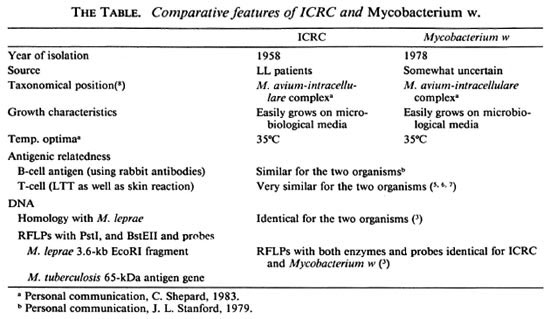- Volume 62 , Number 1
- Page: 131–2
Leprosy vaccines f rom cultivable mycobacteria
This department is for the publication of informal communications that are of interest because they are informative and stimulating, and for the discussion of controversial matters. The mandate of this JOURNAL is to disseminate information relating to leprosy in particular and also other mycobacterial diseases. Dissident comment or interpretation on published research is of course valid, but personality attacks on individuals would seem unnecessary. Political comments, valid or not, also are unwelcome. They might result in interference with the distribution of the JOURNAL and thus interfere with its prime purpose.
To the Editor:
Using a vaccine containing Mycobacterium w , Mukherjee, et al. (4) have basically obtained, albeit on a larger sample, results similar to those reported earlier by us with ICRC vaccine (1, 2). Both of the vaccines, which are prepared from cultivable mycobacteria, induce lepromin conversion in a majority of lepromatous leprosy patients, associated with upgrading of tissue reaction and accelerated bacillary clearance. Some patients even show reversal reaction (1,4).
A comparative account of the two mycobacteria makes interesting reading (The Table).

Cultural characteristics, similarity of protein antigens and, especially, identical RFLP patterns indicate that the two organisms, ICRC and Mycobacterium w , may not be very much different, explaining the similarity of the observations. The results from two independent laboratories further show that vaccines containing cultivable mycobacteria, exhibiting crossreactivity with M. leprae , could be effective immunotherapeutic agents (2, 4).
- M. G. Deo, M.D.,
Ph.D., F.A.M.S., F.N.A.
Director
Cancer Research Institute
Parel, Bombay 400012, India
REFERENCES
1. BHATKI, W. S., CHULAWALA, R. G., BAPAT, C. V. and DEO, M. G. Reversal reaction in lepromatous patients induced by a vaccine containing killed ICRC bacilli-a report of five cases. Int. J. Lepr. 51(1984)466-472.
2. DEO, M. G., BAPAT, C. V., BHALERAO, V., CHATUR-VEDI, R. M., CHULAWALA, R. G. and BHATKI, W. S. Antileprosy potentials of the ICRC vaccine: a study in patients and healthy volunteers. Int. J. Lepr. 51(1984)540-549.
3. GROSSINSKY, C. M., JACOB, W. R., CLARK-CURTISS, J. E. and BLOOM, B. R. Genetic relationship among Mycobacterium leprae , Mycobacterium tuberculosis , and candidate leprosy vaccine strains determined by DNA hybridization: identification of an M. leprae-specific repetitive sequence. Infect. Immun. 57(1989)1535-1541.
4. MUKHERJEE, A., ZAHEER, S. A., SHARMA. A. K., MISRA, R. S., KAR, H. K., MUKHERJEE, R. and TAL- WAR, G. P. Histopathological monitoring of an immunotherapeutic trial with Mycobacterium w. Int. J. Lepr. 60(1992)28-35.
5. MUSTAFA, A. S. and TALWAR, G. P. Five cultivable mycobacterial strains giving blast transformation and leucocyte migration inhibition of leucocytes analogous to Mycobacterium leprae . Lepr. India 50(1978)498-508.
6. MUSTAFA, A. S. and TALWAR, G. P. Delayed hypersensitivity skin reactions to homologous and heterologous antigens in guinea-pigs immunized with M. leprae and four selected cultivable mycobacterial strains. Lepr. India 50(1978)509-519.
7. SAHIB, H. S. M. and VELLUT, C. Some observations on skin reactions induced by lepromin and four other mycobacterial antigens. Lepr. India 50(1978)579-587.
8. STANFORD, J. L. Immunotherapy for mycobacterial disease. In: The Biology of the Mycobacteria. Vol. 3. Clinical Aspects of Mycobacterial Disease. Ratledge, C, Stanford, J. and Grange, J. M. London: Academic Press, 1989, 567-596.